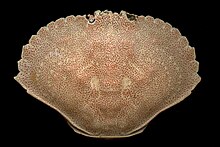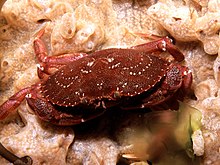|
Cancer irroratus
Cancer irroratus (common name the Atlantic rock crab or peekytoe crab) is a crab in the genus Cancer. It is found from Iceland to South Carolina at depths up to 2,600 ft (790 m), and reaches 133 mm (5.2 in) across the carapace. Distribution This crab species occurs on the eastern coast of North America, from Iceland to South Carolina.[1] Rock crabs live over a large depth range, from well above the low tide line to as deep as 2,600 feet (790 m).[1] DescriptionCancer irroratus has nine marginal teeth on the front edge of the carapace beside each eye,[1] and reaches a carapace width of 5.25 inches (133 mm).[2] These crabs are similar in color to, and overlap in size with, the Jonah crab, Cancer borealis.[2] The two species can indeed be distinguished by the purplish-brown spots on the carapace of C. irroratus (contrasting with the yellow spots of C. borealis), and by the smooth edges to the teeth on the edge of the carapace (denticulate in C. borealis).[2] FisheriesThe rock crab has recently become a popular culinary item. The name "peekytoe crab" refers to the fact that the legs are "picked" (a Maine colloquialism meaning "curved inward").[3] Until about 1997, they were considered a nuisance species by the lobster industry because they would eat the bait off of lobster traps.[1] References
External links
|
||||||||||||||||||||||||||||||
